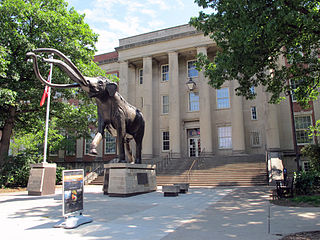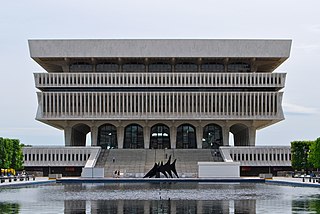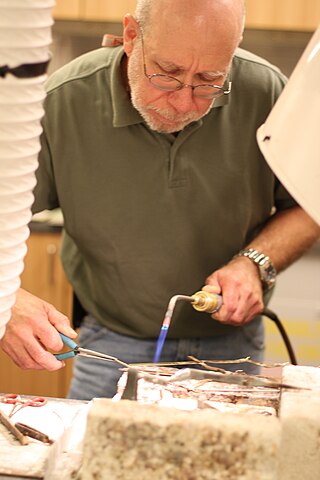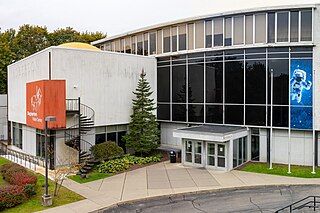
The Royal Ontario Museum (ROM) is a museum of art, world culture and natural history in Toronto, Ontario, Canada. It is one of the largest museums in North America and the largest in Canada. It attracts more than one million visitors every year, making it the most-visited museum in Canada. It is north of Queen's Park, in the University of Toronto district, with its main entrance on Bloor Street West. Museum subway station is named after it and, since a 2008 renovation, is decorated to resemble the ROM's collection at the platform level.

The Field Museum of Natural History (FMNH), also known as The Field Museum, is a natural history museum in Chicago, Illinois, and is one of the largest such museums in the world. The museum is popular for the size and quality of its educational and scientific programs, and its extensive scientific specimen and artifact collections. The permanent exhibitions, which attract up to 2 million visitors annually, include fossils, current cultures from around the world, and interactive programming demonstrating today's urgent conservation needs. The museum is named in honor of its first major benefactor, Marshall Field, the department-store magnate. The museum and its collections originated from the 1893 World's Columbian Exposition and the artifacts displayed at the fair.

The Burke Museum of Natural History and Culture is a natural history museum in Seattle, Washington, in the United States. Established in 1899 as the Washington State Museum, it traces its origins to a high school naturalist club formed in 1879. The museum is the oldest in Washington state and boasts a collection of more than 16 million artifacts, including the world's largest collection of spread bird wings. Located on the campus of the University of Washington, the Burke Museum is the official state museum of Washington.

The University of Nebraska State Museum, also known as Morrill Hall, founded in 1871, is a natural history museum featuring Nebraska biodiversity, paleontology, and cultural diversity, located on the University of Nebraska–Lincoln City Campus near the corner of 14th and Vine Streets in Lincoln, Nebraska, United States. The museum houses Mueller Planetarium, a hands-on science discovery center, and the Elephant Hall, where visitors can see the world's largest articulated fossil mammoth among the collection of fossil elephants. Also featured are interactive paleontology exhibits, a dinosaur gallery, ancient life and evolution exhibits, wildlife dioramas, gems and minerals, American Indian and African exhibits, and a temporary exhibit gallery featuring rotating displays on diverse topics including photography, quilts and fine arts.

The Denver Museum of Nature & Science is a municipal natural history and science museum in Denver, Colorado. It is a resource for informal science education in the Rocky Mountain region. A variety of exhibitions, programs, and activities help museum visitors learn about the natural history of Colorado, Earth, and the universe. The 716,000-square-foot (66,519 m2) building houses more than one million objects in its collections including natural history and anthropological materials, as well as archival and library resources.

The Anchorage Museum is a large art, history, ethnography, ecology and science museum located in a modern building in the heart of Anchorage, Alaska. It is dedicated to studying and exploring the land, peoples, art and history of Alaska.

The Evansville Museum of Arts, History & Science is a general-interest museum located on the Ohio riverfront in downtown Evansville, Indiana, United States. Founded in 1904, it is one of Southern Indiana's most established and significant cultural institutions, with comprehensive collections in art, history, anthropology and science. It has a permanent collection of over 30,000 objects including fine arts, decorative arts, historic documents and photographs, and anthropologic and natural history artifacts. Also on the museum's campus is the Evansville Museum Transportation Center, featuring Southern Indiana transportation artifacts from the late 19th through the mid-20th centuries. The museum is accredited by the American Alliance of Museums.

The Everhart Museum of Natural History, Science & Art is a non-profit art and natural history museum located in Nay Aug Park in Scranton, Pennsylvania, United States. It was founded in 1908 by Dr. Isaiah Fawkes Everhart, a local medical doctor and skilled taxidermist. Many of the specimens in the museum's extensive ornithological collection came from Dr. Everhart's personal collection.

The Illinois State Museum features the life, land, people and art of the State of Illinois. In addition to natural history exhibits, the main museum in Springfield focuses on the state's cultural and artistic heritage. Exhibits include local fossils and mining, household displays from different historic periods, dioramas of Native American life, archaeological and ethnographic artifacts, and a collection of glass paperweights.

The Indiana State Museum is a museum located in downtown Indianapolis, Indiana, United States. The museum houses exhibits on the science, art, culture, and history of Indiana from prehistoric times to the present day.

The New York State Museum is a research-backed institution in Albany, New York, United States. It is located on Madison Avenue, attached to the south side of the Empire State Plaza, facing onto the plaza and towards the New York State Capitol. The museum houses art, artifacts, and ecofacts that reflect New York’s cultural, natural, and geological development. Operated by the New York State Education Department's Office of Cultural Education, it is the oldest and largest state museum in the US. Formerly located in the State Education Building, the museum now occupies the first four floors of the Cultural Education Center, a ten-story, 1,500,000-square-foot (140,000 m2) building that also houses the New York State Archives and New York State Library.

The Grace Museum is located in Abilene, Texas, United States. The museum is accredited by the American Alliance of Museums (AAM). The Grace Museum houses five art galleries featuring rotating art exhibitions and artwork from the permanent collection; a history gallery with permanent and rotating exhibits featuring Abilene, Taylor County, and West Texas artifacts; an art library; an education center and an interactive gallery for children and families. The Abilene Fine Arts Museum was founded in 1937 by the Art League of the Abilene Woman's Club. The art museum was housed in various downtown locations and Rose Park before the current facility was renovated in 1992. Since 1992, the museum has existed as The Museums of Abilene, Grace Cultural Center and the name was officially changed to The Grace Museum in 1998.

The Museum of Arts and Sciences, often referred to as MOAS, is a museum in Daytona Beach, Florida, United States. MOAS is the primary art, science and history museum in Central Florida. Programs are sponsored in part by the State of Florida, Department of State, Division of Arts & Culture, the Florida Arts Council, the National Endowment for the Arts and the County of Volusia.The museum is a member of the American Alliance of Museums and an affiliate of the Smithsonian Institution. It is home to the Cici and Hyatt Brown Museum of Art which contains the largest collection of Florida art in the world, The Lowell and Nancy Lohman Planetarium, the only planetarium located on the Space Coast, as well as 30,000 artifacts, making it one of the largest museums in central Florida.

The Prehistoric Museum, USU-Eastern, formerly known as the College of Eastern Utah Prehistoric Museum, is a museum accredited by the American Alliance of Museums located in Price, Utah. The museum seeks to promote public understanding of prehistory through interpretive exhibits, educational programs, collections, and research. The museum is located near many paleontological and archaeological sites in a region known as Castle Country, notably in the San Rafael Swell and nearby canyons throughout the Book Cliffs area such as Nine Mile Canyon and Range Creek Canyon.

The Museum of Texas Tech University is part of Texas Tech University in Lubbock, Texas. It is made up of the main museum building, the Moody Planetarium, the Natural Science Research Laboratory, the research and educational elements of the Lubbock Lake Landmark, and the Val Verde County research site. It features collections in anthropology, fine arts, clothing and textiles, history, natural sciences and paleontology.

The Idaho Museum of Natural History (IMNH) is the official state natural history museum of Idaho, located on the campus of Idaho State University (ISU) in Pocatello. Founded in 1934, it has collections in anthropology, vertebrate paleontology, earth science, and the life sciences. Additionally, it contains an archive of documents and ethnographic photographs.

The Roswell Museum was founded in 1936 and is located in Roswell, New Mexico, United States. The museum features exhibits about the art and history of the American Southwest, as well as the Robert H. Goddard laboratory.

A mount maker is responsible for the creation of structures called object mounts used to provide unobtrusive physical support, stability, and security of objects while on display, in storage, or being transported to museums, art galleries, libraries, archives, botanical gardens or other cultural institutions. Protection and long-term conservation of the object is a key goal of mount makers. This is accomplished through careful design, selection of materials and manufacturing process that will not inadvertently harm the object, and a cautious installation process of the object into its place in an exhibit. Professionals in this field can be employed directly by an institution, be independent contractors, or work as part of larger cultural institution exhibit design firms.

An Objects conservator is a professional, working in a museum setting or private practice, that specializes in the conservation of three-dimensional works. They undergo specialized education, training, and experience that allows them to formulate and implement preventive strategies and invasive treatment protocols to preserve cultural property for the future. Objects conservators typically specialize in one type of material or class of cultural property, including metals, archaeological artifacts, ethnographic artifacts, glass, and ceramic art. Objects conservation presents many challenges due to their three-dimensional form and composite nature.

The Roberson Museum and Science Center is located in Binghamton, New York. The museum's exhibits focus on art, local history, science, and natural history.





















